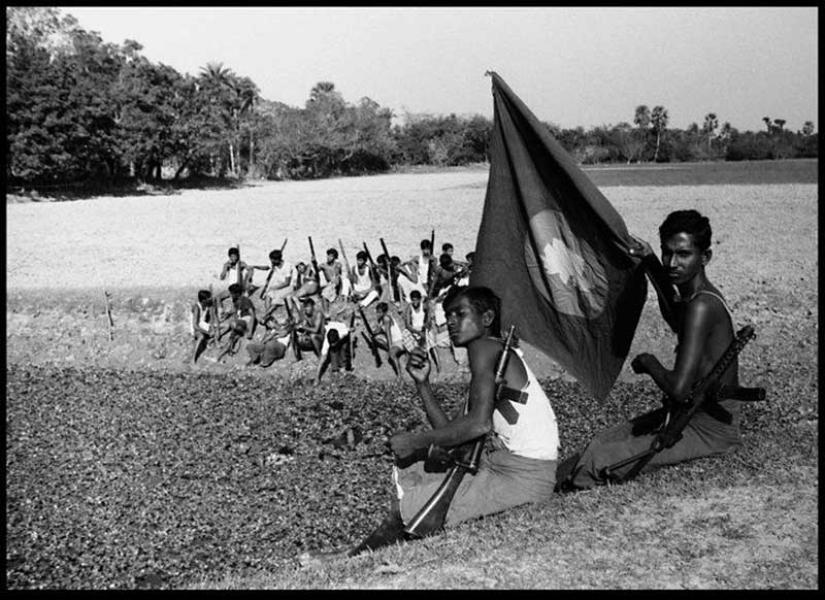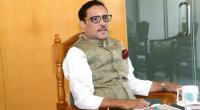 From 2004, the Liberation War Museum of Bangladesh started a nation-wide programme where school-going children asked their families and neighbours about their memories from 1971 and wrote them down. Through this initiative, the Museum has been able to collect over 51,000 testimonies from the 64 districts of Bangladesh. This year, we bring to you some snippets of the oral history that the Museum is painstakingly continuing to collect and preserve through the programme ‘Notun Projonmoke Muktijuddher Chetonay Udbuddhokoron” (Inspiring the new generation through the spirit of the Liberation War)
From 2004, the Liberation War Museum of Bangladesh started a nation-wide programme where school-going children asked their families and neighbours about their memories from 1971 and wrote them down. Through this initiative, the Museum has been able to collect over 51,000 testimonies from the 64 districts of Bangladesh. This year, we bring to you some snippets of the oral history that the Museum is painstakingly continuing to collect and preserve through the programme ‘Notun Projonmoke Muktijuddher Chetonay Udbuddhokoron” (Inspiring the new generation through the spirit of the Liberation War)
It is not possible to explain what war is
My name is Md Nazim Uddin, and I am an injured freedom fighter. In 1971 when I joined the Liberation War forces, there was a section of our society who did not want our independence – the Razakars and Al-Badr. They used to hunt out the young men from the village and take them away to their deaths. Once this started to escalate, about 10-15 young men from my village in Jamalpur, including myself, went off to India to receive training and become freedom fighters.
I was trained for one month in Mahendraganjin India. From there, I went to the Dalu camp in Meghalaya. There was scarcely any food there. I survived for three days on just bananas. Later helicopters came with rations, mainly rice, which we used to make khichuri. That khichuri was always filled with dead insects – the sight of them would bring tears to our eyes! But we were starving, so we would just pick them out and eat the food anyway. We also got help from the indigenous people living there. They would give us bananas, jackfruit and chirain exchange for the ration rice.
In August, we entered Bangladesh and started our guerrilla warfare. On Oct 17, we heard from a secret source that the Pakistani army and Razakars were planning on attacking Chandraghona Bazaar in Sherpur and burning everything to the ground. We decided to wait for them, hidden next to the roads leading there from the Kayda village in Nokla. At five in the morning, I asked a lady who lived there whether there are any Razakars nearby. The lady replied - “I am a Muslim, I won’t lie, we help the freedom fighters.” We felt encouraged by her words but in a few moments, the Razakars and the army attacked us from behind. We fought them off for almost six hours, and we lost 13 freedom fighters in that battle. A brother of mine was riddled with bullets and died in front of my eyes. I tried to go to him and save him, but in the attempt got shot in my left thigh. The village doctor gave me treatment in the aftermath, and I was later sent to a hospital in Mahendraganj, India. I recovered and came back to the war again.
We had a hideout in the Kajaikata village. We heard from our sources that Razakars were abducting young women and taking them to Pakistani camps. After hearing that, we gathered our forces to hit the Pakistani army at Itail Bazaar. Suddenly, we were recognised by a Razakar andhad no option but to run for our lives. We jumped into a river and swam like mad while they shot at us in the water. By Allah’s grace, we somehow survived. We returned the next day and shot that Razakar.
On November 9, two Pakistani soldiers were taking an early train from the Piyarpur station in Jamalpur to Mymensingh. A few people on the streets spotted them and informed us. We instantly surrounded them and after almost three hours of exchanging fire, we managed to shoot them.
On November 16, the Pakistani army abducted three Hindu women from a house in Nokla. When we heard of this, we surrounded their camp. We fought them for almost four hours and finally, they surrendered. By that time, one of those women had already died from their violent abuse, but we were able to rescue the other two. After they surrendered, we tied them up and took them to a riverside. Our company commander told us to shoot them. I hesitated at first, but when I thought of what they did to those women, and the lady who was already dead from it, I shot them all.
We were 95 freedom fighters in total, who were part of the same company and entered Bangladesh together to fight. Out of them, 19 of my comrades lost their lives during the different battles we faced. It is not possible to explain in words what war is. No amount of history books will ever make you understand how many mothers lost their children, how many women were tortured and abused by these monsters. I hope we will remember them for as long as this world exists.
Md Nazim Uddin
Collected by Elma Siddiqui
Jamalpur High School
There were hundreds of decomposing skulls there
From the 15th of the Bengali month of Bhadra, my fellow freedom fighters were staying for a few nights at our house in the village of Bangshijhara, Panchagarh. The Pakistani army had always suspected us and we knew they would come sooner or later, so when the freedom fighters were leaving, they planted mines in the surrounding area. There was an aisle cut through a piece of land behind our house, and they planted mines there as well. As soon as the Pakistani soldiers stepped foot there, the mines exploded, and the leader of their group died. Two others were injured as well.
The army were staying at the bunker at PanimachPukuri, and they took the dead body there. A few other soldiers entered the Haribhasha union. They set fire to the Ghagra East Pakistan Rifles camp and the house of the late Chairman Tajmul Haque Pradhan. There was a boy from our village – Mohammed Harunur Rashid Pradhan – who raised the flag of Bangladesh in the Chinikal area of Panchagarh. The Pakistanis shot him right then and there. We buried him later in Kotgach, India.
A few days after there was a battle between the freedom fighters and the Pakistani army at the HaribhashaHaat, and the Pakistani army retreated. Two days later, we fired on the bunker where their soldiers were staying and forced them to retreat to Thakurgaon.
When the Pakistanis launched a rocket at Panchagarh Sugar Mill, the whole of Panchagarh was covered with black smoke and fire. Crowds of people started to run for India. When we saw this state of things, my neighbours and I also took shelter in the schools and bazaars in India. After a few days, the Indian government set up refugee camps where most of these people took shelter. We spoke to a lot of refugees there, and learned that thousands of people had run away and taken refuge near the bazaar of the Jetibhanga area of Panchagarh. Most of the people crowded here were from the Hindu community and they were paralysed with fear - there was nowhere else to run.
With the help of Razakars, the Pakistanis came after these people and stood them in lines next to the river and fired at random. The bodies were then dumped into a mass grave. After we gained independence, I went back to that area and saw that there really were hundreds of decomposing skulls there.
Hafizur Rahman
Collected by Matilipika Rani
Haribhasha Girls’ High School
The bodies used to float on the Karnaphuli river
During the Liberation War, my grandfather was working at the Kaptai power plant and used to live on the Kaptai project with his family. When the Pakistani army reached there, they decided to blow up the Kaptai dam. They even brought out the dynamite they wanted to use. However, they did not really understand the consequences of this action – that it would make the entire area go underwater. The captain of this group of Pakistani soldiers, Harunur Rashid, came into the control room and informed the workers of their plan. My grandfather M A Hamid, his colleagues Omar Ali, Mushtaq Ahmed and a few others were there.
When they heard what the Pakistanis meant to do, they were terrified and knew they had to be stopped. My grandfather and his colleagues tried to speak to them in broken Urdu. After a lot of convincing, Captain Harunur Rashid changed his mind, and the town was saved from disaster.
However, they were not going to be let off so easy. The Pakistanis stationed there ended up killing hundreds of people in the area, including the project manager of the power plant Mr Shamsuddin. There were a lot of non-Bengalis at the plant at the time, but Shamsuddin did not differentiate – he tried to protect them all. In spite of that, Captain Harunur Rashid summoned him to the top of the dam one day and shot him for no reason.
As the war raged on, the distrust between the Bengalis and non-Bengalis grew, and the number of deaths escalated. Whoever the Pakistanis thought to be suspicious were taken into a tunnel and killed. The bodies would float from there to the Karnaphuli River. They were such merciless murderers!
Collected by Cadet Towsif
Comilla Cadet College
 National
National
41408 hour(s) 5 minute(s) ago ;
Morning 03:00 ; Tuesday ; Jul 08, 2025
Stories from 1971
Send
Bangla Tribune Desk
Published : 15:31, Mar 26, 2019 | Updated : 16:42, Mar 26, 2019
Published : 15:31, Mar 26, 2019 | Updated : 16:42, Mar 26, 2019
0 ...0 ...
/hb/
Topics: Top Stories
- KOICA donates medical supplies to BSMMU
- 5 more flights to take back British nationals to London
- Covid19: Rajarbagh, Mohammadpur worst affected
- Momen joins UN solidarity song over COVID-19 combat
- Covid-19: OIC to hold special meeting
- WFP begins food distribution in Cox’s Bazar
- WFP begins food distribution in Cox’s Bazar
- 290 return home to Australia
- Third charter flight for US citizens to return home
- Dhaka proposes to postpone D8 Summit
Unauthorized use of news, image, information, etc published by Bangla Tribune is punishable by copyright law. Appropriate legal steps will be taken by the management against any person or body that infringes those laws.
Bangla Tribune is one of the most revered online newspapers in Bangladesh, due to its reputation of neutral coverage and incisive analysis.
F R Tower, 8/C Panthapath, Shukrabad, Dhaka-1207 | Phone: 58151324; 58151326, Fax: 58151329 | Mob: 01730794527, 01730794528


